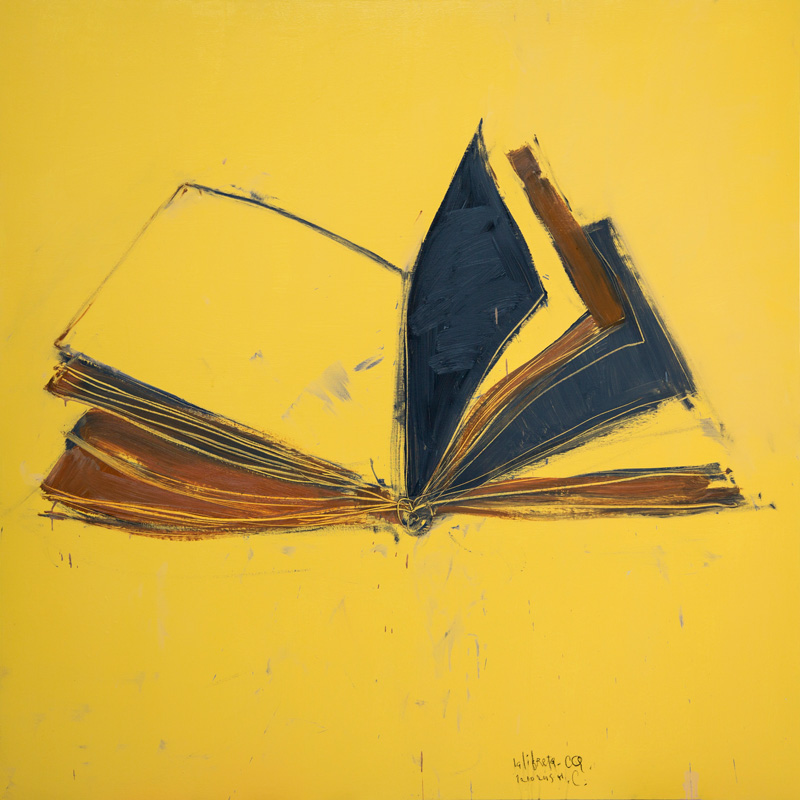
Carlos Quintana
About:
Carlos Quintana and his mixed-up heads in New York
At the beginning of 2012, Carlos Quintana (1966, Cuba) showed at the halls of the National Museum of Fine arts in Cuba, a group of pieces that got the attention for their bond with the Asian cosmology in simultaneity with our syncretistic cults. Titles as Awó orumila sequito y meditando offered a singular interpretation of the Afro-Cuban mythology, at the same time linked with the Chinese Buddhist practice. Other canvases, also in a subtle, elliptic and very suggestive way, showed the conceptual synthesis between so diverse worlds and so similar sensibilities, even appealing to the humorous comment inside the canvas itself.

Untitled.
From April 27th to May 30th this year, another exhibition by this artist is announced, this time at the National Arts Club in New York where he goes with a selection of works in those bones, skulls, ngangas paleras and Buddhist monks liven up the chosen topics, without abandoning that cunning irony that always accompanies his painting.
His great format canvases seem enormous cabalistic registrations in which author and spectator could plot to exorcize all type of mischief. The backgrounds, sometimes neuter, sometimes of saturated colors, serve as contrast to the exercise of free drawing, supporting contours and forms that seem surrealist although figurative. To the expressionist use of color it is necessary to add the filling brushstrokes, as chaotic as vigorous, impelled by a pictorial furor that does not decrease over the years.

What impacts me the most of his canvas, it is the passionate vigor that comes off from them, revealing capricious gestures that nurtures his own warp. Quintana’s work does not allow the quiet, reflexive and academic appreciation, on the contrary, his painting is subversive, bouleversant, spuring; because this artist knows how to disassemble the orthodoxy of myths he mentions, loading them of an interpretive potential of which either a palero, a derviche, a shaman, Taoist philosopher, a barber or a freemason would equally participate.
There is perversity in the faces of his Tibetan monks whose hands, beyond joining in votive expression, writhe to hide the savored sin that struggles to overflow from their iridescent habits. In the characters posing resigned between a skull and a rooster, a malicious contrast is discovered in connection with that one who, inside the same scene, next to a group of upside-down figures, and with the same effrontery of The Tarot Hanged Man, greets the public announcing unimaginable premonitions. In other canvases, other fellows sometimes look toward the spectators threatening to participate of the witches’ sabbath, sometimes intimidating, recriminating their passive view or making fun of their perplexity.

Untitled, 1995.
One of the so many peculiar features conforming Carlos Quintana’s creative poetic resides in the posture of many of his characters: In seated attitude, they levitate over nothing; they invoke a delay, a wait in suspension, something that is delayed without bringing up fatigue, but the unusual serenity of the Chinese patience.
There is, on the other hand, a conflict that crosses all his work and rests in the dichotomy among the being and not being, with the result that has privileged the representation of human head and skulls, varying the expressive possibilities of his profile. Nobody would say that it is a direct invocation to Obatalá, or to any other yoruba deities. Rather the Afro-Cuban feeling is digested and returned in the daily universal projection, a point far from the fable. That skull that innocently rests on a table has more from Hamlet than from Olofi, and the white rooster in front of the family group is closer to Abela’s Guajiros than to bembé.

A creator whose training has depended more on self-didactism than on scholasticism, it is difficult to find influences and coincidences; but, artist at last, traces of his time or their predecessors will be found. As Proust said, there are bits of Turner in Poussin work of, and a Flaubert phrase in Montesquieu. However, once in contact with Carlos Quintana’s pieces, it will be hard to forget or confuse his topic and his style, his aura, his nuances, his ghosts: the mocking persistence of his mixed-up heads in memory.( Berta Carricarte / Art on Cuba, 23 March, 2015)
